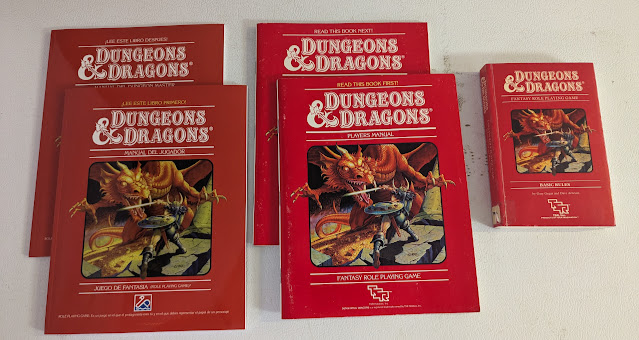Today is the start of my "Shadow Week" where I am going to spend some time with various Shadow Elves and Shadow Fey products. Today in lieu of a Monstrous Monday I want to talk about a classic Basic D&D (BECMI) resource,
GAZ13 The Shadow Elves.
The world of Mystara/The Known World doesn't have Drow, but they do have Shadow Elves that fill the same ecological niche, but not the same mythological niche. Like the drow, the shadow elves do live underground, are harmed by bright light and separated from the main, light elf, race many centuries ago. And that is where the similarities end.
To understand the Shadow Elves best it is helpful to understand a bit about the world of Mystara and their Immortals.
For the unintiated Mystara does not have gods, but rather immortals, that help guide the affairs of mortals. The immortals in question here are Rafiel and Atzanteotl. I will deal with them in the review, but sufice to say that Immortals of Mystara tend to meddle in the affairs of entire races. Shadow Elves are a prime example. This book is also one of the first introductions to the Hollow World of Mystara.
GAZ13 The Shadow Elves
This book is a 103 pdf, larger PoD book. It was originally published in 1990 and it was written by Carl Sargent and Gary Thomas. Cover art is by the fantastic Clyde Caldwell with interior art by the equally fantastic Stephen Fabian. The book was designed for the Dungeons & Dragons, aka Basic or BECM line. I am reviewing the PDF and PoD version from DriveThruRPG.
The book is split up into a Player's Section and a Dungeon Master's Section. While each is numbered starting at "1". The table of contents (printed) starts with the Players Section, but the book (PDF and POD, and hyperlinked bookmarks) start with the DMs section and then the Player's section. The Player's section does say "READ THIS BOOKLET FIRST!" So I think I am going to star with the Player's Section. This only makes sense since all DMs are also players.
Player's Section
This 32-page section introduces us to the book and to the Shadow Elves. This section also includes the very helpful "Other Books to Use" which gives some resources that would be helpful for a player dealing with the lands of the Shadow Elves, mostly GAZ 5, The Elves of Alheim and GAZ 10 The Orcs of Thar. I also found that GAZ3 The Principalities of Glantri was also useful.

Here we are introduced to the Immortal Rafiel and how he and his works have really guided the Shadow Elves to their modern state after their split with the Light Elves. This covers the history of the Shadow Elves as they know it. It is an interesting read and does exactly what it supposed to do, separates the Shadow Elves from the more popular Drow. You get an idea for the size of the Shadow elf realms (larger than any other country covered by the GAZ series.) and how the various settlements/cities are connected. You get an overview/example of a day in the life a Shadow Elf. The importance of the Shadow Elf shamans (clerics) and the "Soul" crystals in the birth of a new Shadow Elf is covered and how important each birth is. (This is something that is actually revisited in 5th Edition D&D Elves).
There is a great section on Creating and Playing a Shadow Elf. This speaks to the strength of D&D BECMI. It can easily allow a new race/class without "breaking the rules" as it were. Shadow Elves can advance farther than surface elves. This is explained by their unique nature. New skills for Shadow Elves are also covered. There are also many "new" spells for Shadow Elves. I say "new" since many are from AD&D or alterations of other D&D spells. Additionally, you can play a Shadow Elf shaman (cleric). It is one of the best examples of playing a D&D / BECMI Shaman. The Shaman has a few more spells, most of these are newer though there are some reused AD&D spells. Note: I say "reused" not imply that these spells are somehow lesser, they are not. They are all (for the most part) new to D&D BECMI, but players of other editions will recognize them.
The player's section has a yellowish background. It does not make it difficult to read at all, but it does make it visually separate from the DM's section.
Dungeon Master's Section
This section is 64-pages with inserts. The Immortal Rafiel is the primary focus of this section, or at least his importance is stressed. He was not the genesis of the Shadow Elves, but he certainly shaped their evolution. He is the center of their religious life and since religion features so much in their everyday life, Rafiel is central to everything.
While the Player's Section gives us the Shadow Elves as they see themselves, this section gives us Shadow Elves and their history as the Immortals see it. Their story begins 6,000 years ago (5,000 BC) when Mystara was young and Blackmoor was a magical and technological global power. The elves were living in what would become Glantri until 3,000 BC when Blackmoor was destroyed and the Great Rain of Fire happened. Mystara was knocked off her axis and ice caps melted and new ones froze. The Shadow Elves sought safety and sanctuary underground.
Here they encountered the followers of Atzanteotl, and evil Immortal, and some began to follow him, but most moved on and soon found Rafiel. Now here is where things get uniquely "Mystara". Rafiel was a Nuclear Physicist in Blackmoor. The explosion that nearly destroyed Mystara was his reactor. OR his reactor saved him when the Rain of Fire ( not to be confused with the Rain of Colorless Fire from Greyhawk) happened. In any case, this former human now leads and protects the Shadow Elves. Back to history, there is a nice objective timeline that covers what the Shadow Elves have done in their time below the surface. Including learning that others did survive (they thought all life had perished) and what they want to do about Alfhiem. Here you learn also that there are some false beliefs purposely put into the player's section that are corrected here. For example, the "Soul Crystals" do not contain or house the souls of elves as all Shadow Elves believe, instead they are bits of the Radiance (from under Glantri) that are the nuclear equivalent of magic or the magical equivalent of nuclear energy. Science and Magic get blended a lot when dealing with Blackmoor.
Shamans and their roles are also covered in more detail here. It is here since there are secrets that a Shama learns as they progress in levels that are supposed to remain unknown to them at lower levels. A really nice way of doing it if you ask me. This includes some new Shamanic spells.
The geography of the Shadow Elves' lands is covered. Including the towns, major cities, and the passageways in between. Also covered are the possible location of more soul crystals and how many. We also see the different types of animals living near or with the Shadow Elves including the "Skinwing" or a flying dinosaur they use for patrols. This is reminiscent of both the Mahars of Pellucidar and the running lizards of the drow. A couple of other monsters are presented, but I would have liked to have seen some more. Likely these would have been covered in other Gaz products.
There is a neat little section on what everyone else thinks of the Shadow Elves include Glantri scholars, orcs, elves in Alfheim, and a dwarf. Later on, we also get what Shadow Elves in other lands are up too.
Several important NPCs are also covered including Rafiel and Atzanteotl.
There is also a Shadow Elf specific character sheet. I stress function over form.
The PDF has maps you can print out and the Print version has the maps bound in the pages.
The text is easy to read if it is a scan of a printed document.
The PDF is $9.99 and the softcover POD + PDF is $18.00. If you are getting the POD it is worth it to add the $2 to get the PDF to print out the maps and character sheets.
Using this Book and Shadow Elves
If you are unfamiliar with Mystara then some of the ideas mentioned inside will sound "out there" to other D&D players. Nuclear explosions? Post-Apocalypic Elves? Immortal physicists? Aztec like humans living in a Hollow Earth? But they are all perfectly sensible in a Mystara campaign.
The writing of this Gazzateer is top-notch, easily one of the best, and right up there with GAZ 3. The Shadow Elves are also a little more interesting than Drow in my opinion. Their lives make perfect sense once you see things from their own point of view. They would in fact make a fine replacement for the Drow in many games.
The player's section would work "AS IS" for most versions of D&D. Shadow Elf Shamans are easily converted to future D&D Clerics. Adding them as a race or type of elf is also very easy.
Honestly, they are perfect for anyone that wants to play a Drow but wants something that is a little different.
For my Week of Shadow, I want to come back to these guys a little later and see how they might fit in to other types of Shadow Elves / Shadow Fey.

















































